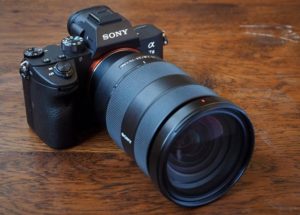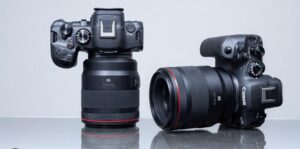When it comes to choosing a new camera, Canon offers a variety of options that cater to different needs and preferences. Two popular models in the market are the Canon EOS R8 and the Canon EOS R5. In this article, we will compare these two cameras in detail to help you make an informed decision. We will look at their specifications, key differences, and who each camera is best suited for.
Canon EOS R8 vs. EOS R5: Which Camera Suits Your Needs Best?
Sensor and Image Quality
Canon EOS R8: The Canon EOS R8 features a 24.2-megapixel full-frame CMOS sensor. This sensor size allows for good image quality with decent low-light performance. The resolution is sufficient for most everyday photography needs, including landscapes, portraits, and even some professional work.
Canon EOS R5: On the other hand, the Canon EOS R5 comes with a 45-megapixel full-frame CMOS sensor. This higher resolution sensor offers exceptional image quality, making it ideal for professional photographers who need to capture a lot of detail. The increased megapixels allow for larger prints and greater flexibility in cropping images without losing quality.
Processing Power
Both the EOS R8 and EOS R5 are powered by the DIGIC X processor. This advanced processor enables fast and efficient performance in both cameras. It supports high-speed shooting, sophisticated autofocus capabilities, and excellent noise reduction, ensuring clear and sharp images even in challenging lighting conditions.
Autofocus System
Canon EOS R8: The EOS R8 uses Canon’s Dual Pixel CMOS AF II system, which offers 1,053 autofocus points. This advanced AF system provides quick and accurate focus, making it suitable for various photography genres, including action shots and wildlife photography.
Canon EOS R5: The EOS R5 also features the Dual Pixel CMOS AF II system with 1,053 autofocus points. However, with its higher resolution sensor, the autofocus system in the R5 is even more precise, allowing for superior tracking of fast-moving subjects and better performance in low-light situations.
ISO Range and Low-Light Performance
Canon EOS R8: The ISO range for the EOS R8 is 100-102,400, expandable to 204,800. This wide ISO range allows for good performance in low-light environments, making it versatile for shooting in various lighting conditions.
Canon EOS R5: The EOS R5 has an ISO range of 100-51,200, expandable to 102,400. While the expandable range is lower than the R8, the R5’s sensor and processing power provide excellent low-light performance, with less noise at higher ISO settings.
Continuous Shooting Speed
Canon EOS R8: The R8 offers a continuous shooting speed of up to 12 frames per second (fps) with the mechanical shutter and up to 40 fps with the electronic shutter. This makes it a great choice for capturing fast-moving subjects, such as in sports or wildlife photography.
Canon EOS R5: The R5 matches the R8 with a mechanical shutter speed of up to 12 fps but offers up to 20 fps with the electronic shutter. While the electronic shutter speed is slower than the R8, the R5’s overall performance and higher resolution make it a strong contender for action photography.
Video Capabilities
Canon EOS R8: The EOS R8 can record 4K UHD video at up to 60 frames per second without cropping. It also offers Full HD recording at up to 180 fps, which is great for creating smooth slow-motion videos.
Canon EOS R5: The EOS R5 significantly surpasses the R8 in video capabilities. It can record 8K DCI video at up to 30 fps and 4K video at up to 120 fps. This makes the R5 an excellent choice for videographers who require high-resolution video and the ability to shoot in slow motion.
Viewfinder and LCD Screen
Canon EOS R8: The R8 features a 2.36 million dots OLED electronic viewfinder (EVF) and a 3.0-inch vari-angle touchscreen with 1.62 million dots. This combination provides a clear and flexible viewing experience, suitable for both composing shots and reviewing images.
Canon EOS R5: The R5 boasts a higher resolution 5.76 million dots OLED EVF, offering an incredibly detailed view of your subject. It also has a slightly larger 3.2-inch vari-angle touchscreen with 2.1 million dots, providing a superior viewing and touch experience.
Storage and Connectivity
Canon EOS R8: The EOS R8 has a single UHS-II SD card slot, which supports fast read and write speeds, making it suitable for most photography and videography needs.
Canon EOS R5: The EOS R5 features dual card slots – one for CFexpress cards and one for UHS-II SD cards. This allows for greater flexibility and faster data transfer speeds, which is particularly useful for professional photographers who shoot in high-resolution or need redundancy for their files.
Both cameras offer Wi-Fi and Bluetooth connectivity, making it easy to transfer images and control the camera remotely using a smartphone or tablet.
Battery Life
Canon EOS R8: The battery life of the EOS R8 is rated at approximately 370 shots per charge (CIPA standard). This is slightly better than the R5, making it a good option for longer shooting sessions without needing to recharge.
Canon EOS R5: The EOS R5 has a battery life of approximately 320 shots per charge (CIPA standard). While this is slightly lower than the R8, it is still adequate for most shooting scenarios, and spare batteries can easily extend shooting time.
Weight and Portability
Canon EOS R8: Weighing in at approximately 461 grams (with battery and memory card), the EOS R8 is lightweight and portable, making it ideal for travel and everyday use.
Canon EOS R5: The EOS R5 is heavier, at around 738 grams (with battery and memory card). While it is less portable than the R8, its robust build quality and advanced features make it a professional-grade camera suitable for demanding shoots.
Conclusion
Both the Canon EOS R8 and EOS R5 are excellent cameras, but they cater to different needs and budgets.
Canon EOS R8: This camera is perfect for enthusiasts and semi-professionals who want a lightweight, versatile camera with good image quality and excellent performance in various shooting conditions. Its affordability and portability make it a great choice for travel, everyday photography, and even some professional work.
Canon EOS R5: The R5 is designed for professional photographers and videographers who require top-of-the-line performance and features. Its high-resolution sensor, superior autofocus, advanced video capabilities, and robust build make it ideal for demanding shoots, including commercial photography, high-end portraits, and professional video production.
Ultimately, the choice between the Canon EOS R8 and the Canon EOS R5 depends on your specific needs, preferences, and budget. Both cameras offer exceptional quality and performance, ensuring you can capture stunning images and videos regardless of which model you choose.





Pingback: Nikon D850 vs. Sony A7IV: A Comprehensive Comparison in 2024
Hey people!!!!!
Good mood and good luck to everyone!!!!!
Pingback: Adobe Premiere Pro Price in Nepal: What You Need to Know - Danish Alam